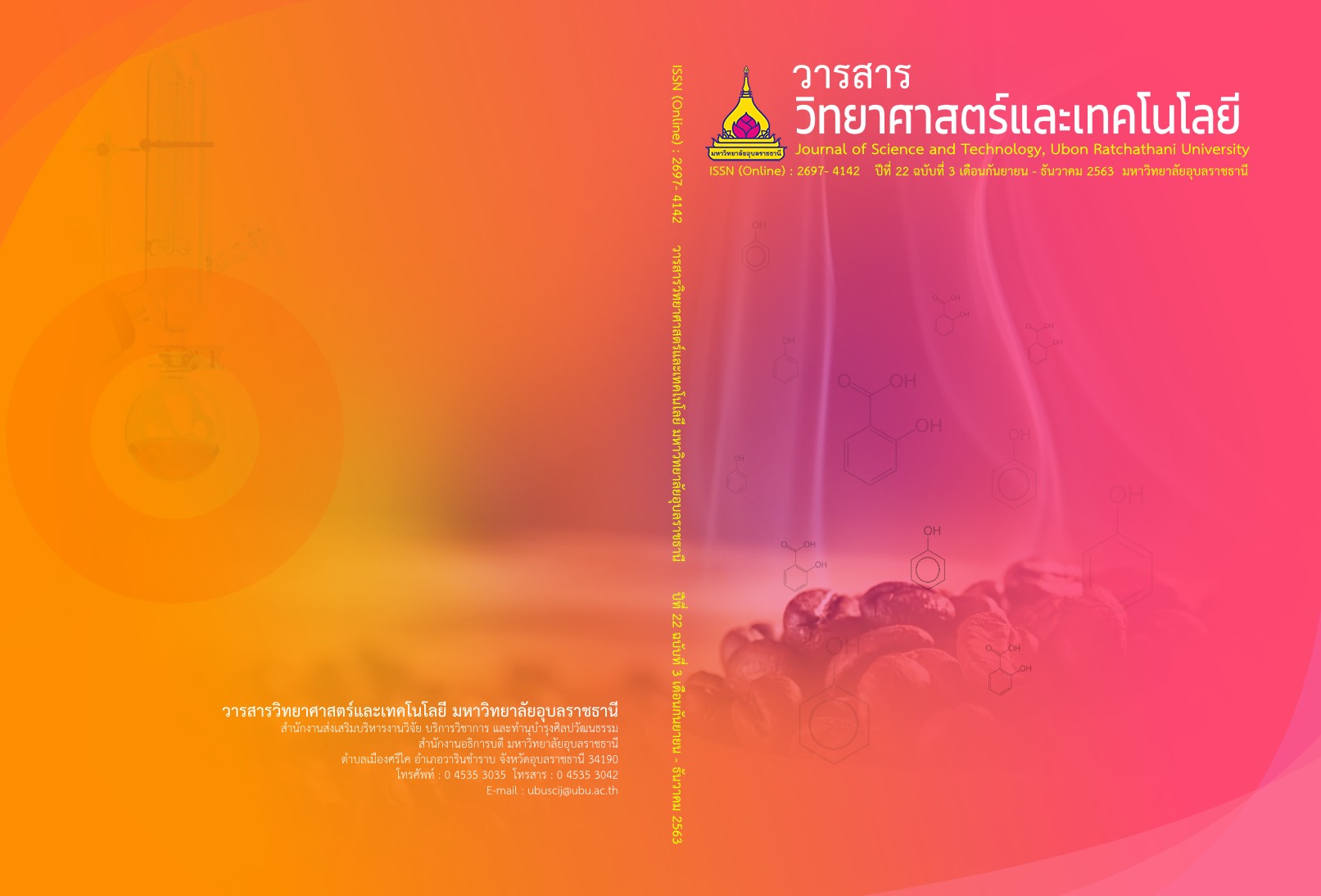การทดสอบประสิทธิภาพในการยับยั้งการเจริญของเชื้อแบคทีเรียของเครื่องผลิตโอโซน
Main Article Content
บทคัดย่อ
การศึกษานี้มีวัตถุประสงค์เพื่อทดสอบความสามารถของเครื่องผลิตโอโซนที่พัฒนาขึ้นโดยคณะวิศวกรรมศาสตร์ มหาวิทยาลัยอุบลราชธานี ในการยับยั้งการเจริญของแบคทีเรียทดสอบต่าง ๆ ซึ่งได้แก่ Escherichia coli (E. coli), Staphylococcus aureus (S. aureus), Bacillus cereus (B. cereus) และ Extended Spectrum Beta Lactamase Escherichia coli (ESBL E. coli) ซึ่งเป็นตัวแทนของแบคทีเรียแกรมลบ แบคทีเรียแกรมบวก แบคทีเรียที่สร้างสปอร์ และแบคทีเรียดื้อยา ตามลำดับ จากการศึกษาพบว่าเมื่อใช้ความเข้มข้นเริ่มต้นของแบคทีเรียทดสอบเท่ากับ 0.5 McFarland ป้ายลงบนอาหารเลี้ยงเชื้อ BHI agar แล้วนำไปอบด้วยโอโซนเป็นเวลา 60 นาที แบคทีเรียทดสอบทุกชนิดถูกยับยั้งได้ นอกจากนี้ผลการทดลองยังแสดงให้เห็นว่าระยะเวลาในการอบโอโซน 60 นาที ยังสามารถยับยั้งแบคทีเรียทดสอบที่มีความเข้มข้นเริ่มต้นเท่ากับ 1, 2 และ 3 McFarland ได้ อย่างไรก็ตามเมื่อดำเนินการทดลองเช่นเดิม โดยใช้ความเข้มข้นเริ่มต้นของแบคทีเรียทดสอบเท่ากับ 0.5 McFarland แต่ลดเวลาในการอบโอโซนลงเป็น 10, 20, 30, 40 และ 50 นาที พบว่า การอบโอโซนเป็นเวลา 10 และ 20 นาที ไม่สามารถยับยั้งแบคทีเรียทดสอบทุกชนิดได้ แต่การอบโอโซนเป็นเวลา 30, 40 และ 50 นาที สามารถยับยั้ง E. coli และ S. aureus ได้ แต่ไม่สามารถยับยั้ง B. cereus และ ESBL E. coli จากการศึกษานี้ทำให้สามารถสรุปได้ว่าหากต้องนำเครื่องผลิตโอโซนนี้ไปใช้งานจริงและต้องการให้ยับยั้งแบคทีเรียได้ทุกประเภทควรใช้เวลาในการอบโอโซนเป็นเวลาอย่างน้อย 60 นาที
Article Details
บทความที่ได้รับการตีพิมพ์เป็นลิขสิทธิ์ของ วารสารวิทยาศาสตร์และเทคโนโลยี มหาวิทยาลัยอุบลราชธานี
ข้อความที่ปรากฏในบทความแต่ละเรื่องในวารสารวิชาการเล่มนี้เป็นความคิดเห็นส่วนตัวของผู้เขียนแต่ละท่านไม่เกี่ยวข้องกับมหาวิทยาลัยอุบลราชธานี และคณาจารย์ท่านอื่นๆในมหาวิทยาลัยฯ แต่อย่างใด ความรับผิดชอบองค์ประกอบทั้งหมดของบทความแต่ละเรื่องเป็นของผู้เขียนแต่ละท่าน หากมีความผิดพลาดใดๆ ผู้เขียนแต่ละท่านจะรับผิดชอบบทความของตนเองแต่ผู้เดียว
เอกสารอ้างอิง
[2] Chipperfield, M.P., Hossaini, R., Montzka, S.A. and et al. 2020. Renewed and emerging concerns over the production and emission of ozone-depleting substances. Nature Reviews Earth & Environment. 1: 251-263.
[3] Lu, X., Zhang, L. and Shen, L. 2019. Meteorology and climate influences on tropospheric ozone: a review of natural sources, chemistry, and transport patterns. Current Pollution Reports. 5: 238-260.
[4] Guzzon, R., Nardin, T., Micheletti, O. and et al. 2013. Antimicrobial activity of ozone. Effectiveness against the main wine spoilage microorganisms and evaluation of impact on simple phenols in wine. Australian Journal of Grape and Wine Research. 19: 180-188.
[5] Clavo, B., Santana-Rodríguez, N., Llontop, P. and et al. 2018. Ozone therapy as adjuvant for cancer treatment: Is further research warranted? Evidence-Based Complementary and Alternative Medicine. 2018: 7931849.
[6] Luongo, M., Brigida, A.L., Mascolo, L. and et al. 2017. Possible therapeutic effects of ozone mixture on hypoxia in tumor development. Anticancer Research. 37: 425-435.
[7] Hernandez, F., Menendez, S. and Wong, R. 1995. Decrease of blood cholesterol and stimulation of antioxidative response in cardiopathy patients treated with endovenous ozone therapy. Free Radical Biology & Medicine. 19: 115-119.
[8] Lippmann, M. 1989. Health effects of ozone: a critical review. Journal of the Air & Waste Management Association. 39: 672-659.
[9] Croze, M.L. and Zimme, L. 2018. Ozone atmospheric pollution and Alzheimer's disease: from epidemiological facts to molecular mechanisms. Journal of Alzheimer's disease. 62(2):503-522.
[10] Ximenes, M., Cardoso, M., Astorga, F. and et al. 2017. Antimicrobial activity of ozone and NaF-chlorhexidine on early childhood caries. Brazilian Oral Research. 31: e2.
[11] Summerfelt, S. 2003. Ozonation and UV irradiation—an introduction and examples of current applications. Aquacultural Engineering. 28: 21-36.
[12] Dobrynin, D., Friedman, G., Fridman, A. and et al. 2011. Inactivation of bacteria using DC corona discharge: role of ions and humidity. New Journal of Physics. 13: 103033.
[13] Moore, G., Griffith, C. and Peters, A. 2000. Bactericidal properties of ozone and its potential application as a terminal disinfectant. Journal of Food Protection. 63(8): 1100-1106.
[14] Aydogan, A. and Gurol, M.D. 2006. Application of gaseous ozone for inactivation of Bacillus subtilis spores. Journal of the Air & Waste Management Association. 56(2): 179-185.
[15] Hembach, N., Alexander, J., Hiller, C. and et al. 2019. Dissemination prevention of antibiotic resistant and facultative pathogenic bacteria by ultrafiltration and ozone treatment at an urban wastewater treatment plant. Scientific Reports. 9: 12843.
[16] Elvis, A.M. and Ekta, J.S. 2011. Ozone therapy: A clinical review. Journal of natural science, biology, and medicine. 2(1): 66-70.
[17] Feng, L., Zhang K., Gao, M. and et al. 2018. Inactivation of Vibrio parahaemolyticus by aqueous ozone. Journal of Microbiology and Biotechnology. 28(8): 1233–1246.
[18] Gounaki, I., Lironi, M.A. and Venieri D. 2019. Bacterial inactivation & study of damages in subcellular level during disinfection of aqueous samples. In: Proceedings of the 16th International Conference on Environmental Science and Technology, 4-7 September 2019. Rhodes Island, Greece.
[19] Pudpai, N., Phumkhachorn, P. and Rattanachaikunsopon P. 2017. Isolation and characterization of lytic phages against antibiotic-resistant Escherichia coli. Journal of Science and Technology, Ubon Ratchathani University. 19(Special issue 1): 62-71. (in Thai)
[20] Song, M., Zeng, Q., Xiang, Y. and et al. 2018. The antibacterial effect of topical ozone on the treatment of MRSA skin infection. Molecular Medicine Reports. 17(2): 2449-2455.


